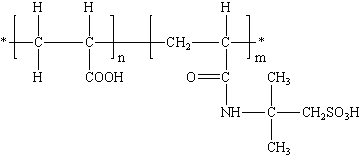Properties:
AA/AMPS is the copolymer of acrylic acid and 2-acrylanmido-2-methylpropanesulfonic acid. Due to including carboxylic group (scale inhibition and dispersion) and sulfonic acid group (strong polarity) in this copolymer, It has high calcium tolerance and good scale inhibition for calcium phosphate, calcium carbonate and zinc scale. When built with organophosphines, the synergic effect is obvious. AA/AMPS is suitable to be used in water quality of high pH and high alkaline, it is one of the ideal scale inhibitor and dispersant on high concentration index.
CAS No. 40623-75-4
Structural Formula:

Specification:
| Items | Index |
|---|---|
| Appearance | Colorless to pale yellow viscous liquid |
| Solid content, % | 40.0 min |
| Free monomer (as AA), % | 0.5 max |
| Density (20℃), g/cm3 | 1.15 min |
| pH(1% water solution) | 3.5-4.5 |
Usage:
AA/AMPS can be used as scale inhibitor and dispersant in open circulating cool water system, oilfield refill water system, metallurgy system and iron & steel plants to prevent sediment of ferric oxide. When built with organophosphorines and zinc salt, the suitable pH value is 7.0~9.5.
It can also be used as dyeing auxiliaries for textile.
Package and Storage:
AA/AMPS liquid: 200L plastic drum,IBC(1000L),customers’ requirement.
Synonyms:
AA-AMPS; AA-AMPSA; Acrylic Acid-2-Acrylamido-2-Methylpropane Sulfonic Acid Copolymer; Sulfonated Polyacrylic Acid Copolymer;
AA/AMPS protective measures:
AA/AMPS, also known as Acrylic Acid/Acrylamide Sodium Salt Copolymer, is a copolymer used in various applications such as water treatment, oilfield chemicals, and personal care products. While AA/AMPS is generally considered to be safe, it is important to follow certain protective measures when handling and using it. Here are some recommended protective measures:
- Personal Protective Equipment (PPE): Wear the following PPE when handling it:
- Gloves: Use chemical-resistant gloves made of materials such as nitrile or neoprene to protect your hands from contact with it.
- Eye Protection: Wear safety goggles or a face shield to protect your eyes from potential splashes or mists.
-
AA/AMPS protective measures:
- Clothing: Wear protective clothing, such as a lab coat or apron, to minimize skin exposure to AA/AMPS.
- Ventilation: Ensure adequate ventilation in the work area to minimize the risk of inhalation of AA/AMPS dust or vapors. Use local exhaust ventilation or other appropriate engineering controls to capture and remove it dust or vapors from the work area.
- Storage: Store it in appropriate containers that are tightly sealed and labeled correctly. Follow recommended storage conditions, such as temperature and humidity requirements, to maintain the stability of AA/AMPS. Keep it away from sources of ignition and incompatible substances.
- Handling: Handle it with care to avoid spills or accidental exposure. Use appropriate transfer equipment and avoid generating dust or splashing AA/AMPS during transfer or use.
- Cleaning: If it spills, clean it up immediately using absorbent materials and personal protective equipment. Dispose of contaminated materials according to applicable regulations and guidelines.
Always refer to the manufacturer’s safety data sheet (SDS) for specific information on hazard identification, recommended control measures, and emergency response procedures for the particular AA/AMPS product you are using.
